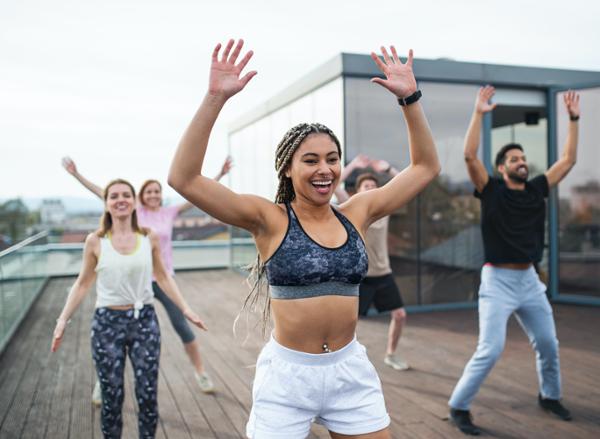features
Insight: Eating disorders: finding a balance
The pandemic has provided a fertile breeding ground for eating disorders. Kath Hudson looks at how the industry can respond

For someone suffering from an eating disorder the triggers are everywhere – calories listed on menus, anxiety-inducing government campaigns about weight and before and after selfies by influencers.
Other culprits include the labelling of ‘good’ and ‘naughty’ food which is embedded in our culture and even characters in books and films who are described as ‘fat’ and seen as less desirable. The list goes on.
Implicit is the need for females to be smaller and males to be ripped and this can be confusing for someone suffering from an eating disorder – they were just doing what they thought was right.
Eating disorders were on the rise pre-pandemic but have skyrocketed around the world since 2020. At its peak during lockdowns, calls to eating disorder charity Beat’s helpline increased to 300 per cent above pre-pandemic levels, while the Royal College of Paediatrics and Child Health is urging parents to look out for signs of eating disorders in children and young people: its snapshot survey suggests some parts of the UK have seen a three- or four-fold increase in cases in the last year.
Consultant in paediatrics at King’s College Hospital and South London and the Maudsley, Dr Simon Chapman, has worked in the field for 10 years and never been so busy. He says referrals trebled in the year after March 2020 and according to the NHS, 2,508 children were admitted to hospital because of eating disorders from April to October 2019 rising to 4,238 in the same period in 2021: an increase of almost 70 per cent.
It appears to be a global issue and medical records from 80 US hospitals show a 25 per cent increase in adolescent eating disorder patients from March 2020 to August 2021. A report published in The Lancet earlier this year, entitled The hidden burden of eating disorders during the COVID-19 pandemic said disorders are most prevalent in high-income countries, but a trend has been observed around the world, especially in east and south Asia. There are also multiple reports from Europe, Australia and North America to show increases.
Thanks again COVID
NHS associate clinical director for children and young people’s mental health, professor Prathiba Chitsabesan, says the rise could partly be attributed to the unpredictability created by the pandemic, including the sense of isolation, disruption to routines and experiences of loss and uncertainty.
Author of Anorexia and other eating disorders, Eva Musby, says her work supporting parents of young people with eating disorders indicates that lockdown and pandemic-induced stress, anxiety and isolation have contributed the rise. However, she cites another reason, which is relevant for our industry – extreme exercise. “Many parents have told me their child got obsessed with online exercise programmes,” she says. “Their eating disorder started with a decision to ‘eat healthy', and/or take part in online workouts. At first it seemed good thing to give structure to the day and lift the mood. Until it became obsessive.”
This is where it can get difficult for our industry, because for an unfortunate minority, exercise can become a weapon they use to punish themselves. Exercise takes on a distorted meaning: it’s compulsive, punishing and used to atone for food which has been eaten – going to the gym becomes a negative addiction, an obsession, a superstition.
How to step in
There’s a lot the industry can do alleviate the problem, and become part of the solution. Firstly, being aware this is a problem and looking out for negative or disordered behaviours.
“It would be beneficial for fitness professionals to be aware of the signs of an eating disorder and the support which is available, as early intervention can play a large role in recovery,” says Umairah Malik, clinical advice coordinator at Beat. “Being aware of warning signs of an eating disorder and including these in messaging could also support people to look out for each other. This should also include signposting for support.”
But how can you tell if a regular member has a problem or is just very keen? Physical size is not an indicator of an eating disorder, it’s about how the individual feels about food and exercise. Physiotherapist and PT at BodyWorksWest in London, Chloe Munro, says communication is key, and it’s important to find out members’ motivations.
“I question all clients at their induction,” says Munro. “They say they want to be toned, but I dig deeper, break it down and ask them what they really mean. Alarm bells ring if they say things which show they’re focused on diet, calories, constant weighing or drawing attention to a part of their body they don’t like.”
Having worked with clients with eating disorders, Munro has found listening has been incredibly powerful: “Be empathetic, allow them to leave feeling they’ve been heard. It’s less about giving advice and more about making the client feel understood, that they’re not alone and that there’s a solution.”
Sometimes training habits need to change: moving away from beasting cardio and towards free weights, as well as promoting a positive mindset towards exercise. “Moving the body and exercising is healing,” says Munro. “Encourage them to see the bigger picture of what exercise can give them beyond weight loss. Movement boosts endorphins and makes you feel strong and empowered. The gym is a social place to make friends and exercise should be a fun habit, not a compulsive one.”
Young people who may be vulnerable to eating disorders are more likely to access online rather than gym-based workouts and experts who work in the field of eating disorders have called on those streaming online workouts – especially high-profile celebrities – to be careful about messaging.
Wider society
Is it possible for health recommendations to be universal if some people need to be persuaded to move, but other will move too much? Does messaging need to change across society? For someone with disordered thoughts around food and exercise, for example, even the basic WHO exercise guidelines would be triggering.
Beat has previously published a report on the risks which government anti-obesity strategies pose to people with eating disorders. The charity wants to see an end to campaigns which ignore the risks to people with eating disorders and calls for a holistic approach to addressing obesity, informed by evidence from the field of eating disorders.
“We’d like to see campaigns move away from weight-shaming and instead support the building of self-esteem and positive behaviour changes,” says Malik. “Anti-obesity campaigns commonly focus on raising anxiety about the impact of obesity, exacerbating anxieties in people with eating disorders. They also fail to recognise that eating disorders and obesity are not separate issues. Many people with eating disorders also have obesity and obesity is a risk factor for developing an eating disorder.”
Musby says messaging could work for everyone as long as it’s one of moderation, balance and respecting and trusting your body. “Your average person shouldn’t be told to count calories, but to develop awareness and respect when it comes to appetite and fullness, combined with self-love and respect for the yumminess and sociable aspects of food,” she says. “Yes, it's harder to put that across than calorie-counting, but it would serve everybody better.
“Everyone, whether couch potato or prone to exercise compulsion, should be getting the message that bodies like to move, and they also like to rest. It's good to discover what we like to do in order to feel energised, not to change body shape.”
• Eating disorders are complex and come about through a mix of genetic, biological and cultural factors. Those suffering often have key personality traits: competitiveness, perfectionism, a need for control and low self esteem. They often judge themselves harshly and compare themselves negatively to others.
• For someone genetically susceptible to an eating disorder, the greatest trigger is negative energy balance – expending more energy than you consume.
• An element of mastery is felt about being able to override the biological drive for food. The compulsion to restrict food or over-exercise is benign to start with, but escalates into a nagging, offensive, critical, frightening and persistent internal voice.
• If sufferers don’t obey they’re overcome with shame and self-loathing. The body is in a battle with itself: part wants to find food to avoid starvation, the eating disorder voice wants to override this
• At any one time, 1.25 million people in the UK are struggling with an eating disorder. (Source: Beat)
• Globally, 2.2 per cent of women and 0.3 per cent of men experience anorexia nervosa at some point, with it typically starting in the mid-teens. (Source: NHS)
• One in six adults is at risk of developing an eating disorder (Source: NHS)
• Many eating disorders are exacerbated by something the individual saw or heard in the media. (Source: Beat)
• People with eating disorders can be diagnosed with anorexia nervosa, ARFID (avoidant/restrictive food intake disorder), binge eating, bulimia nervosa, OSFED (other specified feeding or eating disorder)
• It takes three and a half years on average to get treatment, because people don’t realise they’re ill. It’s common for them to believe they’re not unwell enough to deserve treatment, even if they’re seriously ill.
• The vast majority of people with eating disorders are within a normal weight range.
• Eating disorders are second only to opioid overdose as the deadliest mental illness.
• Eating disorders are treatable and people can and do make full and sustained recoveries.
Before approaching someone get trained and informed and make a plan of what to say. A call to the Beat Helpline (0808 801 0677) could help shape the conversation. It’s a good idea to start by mentioning the observations which have led to the concerns and ask open questions
Choose a safe place to speak where you feel comfortable and won’t be disturbed. Eating disorders are about how a person is feeling, so that could be a starting point for your discussion.
In the early stages of change, people may experience denial, so it may be necessary to have the conversation more than once. Fitness professionals can signpost people to Beat’s Helpline which they can call, as well as using the webchat service, or sending an email. The HelpFinder is an online directory of eating disorder services.
Social media can be unhelpful to those people with low self esteem, who are prone to comparing themselves negatively to others, so suggest they reconsider the amount of time spent on social media and the accounts they follow.
• Bring in eating disorder experts for talks.
• Train team members so they’re qualified to support vulnerable members.
• Don’t sell false dreams to impressionable people: rein in unrealistic expectations at the induction stage and steer clients towards targets which have nothing to do with body size.
• Encourage members to establish an exercise habit which is balanced, moderate and sustainable, not overloaded with cardio, but a mix of vigorous and gentle exercise.
• Fitness professionals should examine their own body and weight biases which might skew how they approach clients.
• Stay away from fat shaming or guilt-driven marketing.
• Get to know your members. If someone is in the gym a lot, find out their motivations so you can work out if there’s disordered thinking going on.
• In marketing, messaging and initial induction, emphasise both the physical and mental health benefits of exercise.
• Talk about the social element of membership and the endorphin release, rather than weight loss and changes in body shape.
• Focus on what bodies can do, not how they look.
• Use diverse marketing imagery, with a range of body shapes. Slim models can be triggering for those with eating disorders, as their eating disorder voice will tell them they’re worthless because they don’t look like that.
• Gently make clients aware of negative self talk and encourage them to practise positive thinking.
• Think about language and whether it could be triggering. Avoid talk of burning off calories or fat, or doing a class to compensate for a few drinks later on.
• Never comment on body shape, not even as a compliment.
• People with eating disorders live by a rigid and exhausting set of rules, so don’t overload them with more, such as do ten press ups every day, or eat more protein.
• Cardio machines can be triggering in the way they detail calories burned. Free weights can encourage people to focus on form, breath and controlling motions.
• People suffering from or recovering from eating disorders often have an element of body shame and/or dysmorphia, so will easily find themselves falling down the hole of comparing themselves with others. Providing smaller breakout spaces with no mirrors can help.
• Work to create a diverse and supportive community of members representing all ages and all types of body shapes and sizes.
• Don’t treat eating disorders as a taboo subject. Have posters for eating disorder charity, Beat, visible and make members aware that support is available.
• Ensure all your staff are aware of these issues.
• Avoid talking about ‘good’ bodies and focus on the fact that all bodies are good no matter what they look like.









































































